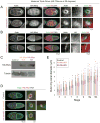The Misshapen kinase regulates the size and stability of the germline ring canals in the Drosophila egg chamber
- PMID: 29753016
- PMCID: PMC6082181
- DOI: 10.1016/j.ydbio.2018.05.006
The Misshapen kinase regulates the size and stability of the germline ring canals in the Drosophila egg chamber
Abstract
Intercellular bridges are conserved structures that allow neighboring cells to exchange cytoplasmic material; defects in intercellular bridges can lead to infertility in many organisms. Here, we use the Drosophila egg chamber to study the mechanisms that regulate intercellular bridges. Within the developing egg chamber, the germ cells (15 nurse cells and 1 oocyte) are connected to each other through intercellular bridges called ring canals, which expand over the course of oogenesis to support the transfer of materials from the nurse cells to the oocyte. The ring canals are enriched in actin and actin binding proteins, and many proteins have been identified that localize to the germline ring canals and control their expansion and stability. Here, we demonstrate a novel role for the Ste20 family kinase, Misshapen (Msn), in regulation of the size of the germline ring canals. Msn localizes to ring canals throughout most of oogenesis, and depletion of Msn led to the formation of larger ring canals. Over-expression of Msn decreased ring canal diameter, and expression of a membrane tethered form of Msn caused ring canal detachment and nurse cell fusion. Altering the levels or localization of Msn also led to changes in the actin cytoskeleton and altered the localization of E-cadherin, which suggests that Msn could be indirectly limiting ring canal size by altering the structure or dynamics of the actin cytoskeleton and/or adherens junctions.
Keywords: Drosophila; Egg chamber; Misshapen (Msn); Oogenesis; Ring canal.
Copyright © 2018 Elsevier Inc. All rights reserved.
Figures





References
-
- Bogard N, Lan L, Xu J, Cohen RS. Rab11 maintains connections between germline stem cells and niche cells in the Drosophila ovary. Development. 2007;134:3413–3418. - PubMed
-
- Cooley L, Verheyen E, Ayers K. chickadee encodes a profilin required for intercellular cytoplasm transport during Drosophila oogenesis. Cell. 1992;69:173–184. - PubMed
-
- Coutelis JB, Ephrussi A. Rab6 mediates membrane organization and determinant localization during Drosophila oogenesis. Development. 2007;134:1419–1430. - PubMed
Publication types
MeSH terms
Substances
Grants and funding
LinkOut - more resources
Full Text Sources
Other Literature Sources
Molecular Biology Databases
Research Materials
Miscellaneous

